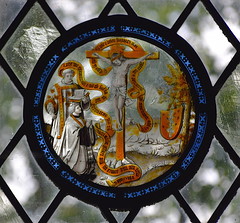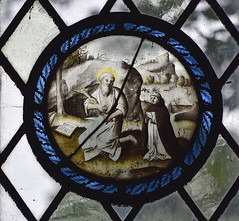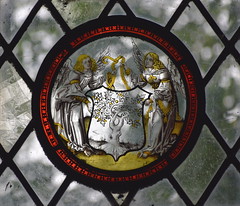| |
|
St
Andrew, Metton Metton is a
church that I keep coming back to. It's handily placed
for revisits, being set just south of Cromer, one of my
regular starting points for bike rides. But there is
something else too, something that seems to call me back
to experience its quiet, dim stillness above the lonely
road of the village.
I first came here with the late Tom Muckley in the summer
of 2005, if you could call it a summer that year. Long,
sultry days in June gave a promise of things to come, but
the promise was never really fulfilled. July was not a
particularly wet one, but neither was it very sunny. In
East Anglia, we awoke again and again to gloomy cloud and
a kind of ineffectual drizzle that eventually petered
out, the clouds breaking. But the days never warmed up,
and all too soon evening closed in. By early August, the
hedgerows were still as green as they had been six weeks
previously, and the conservation areas of graveyards had
become jungles.
There was an illusion that the summer was still held in a
fitful suspense. But already, the barley and wheat fields
were being harvested, the lanes clogged by mud from
combines and tractors, the signs all around of everything
being safely gathered in. The evenings became cooler, the
horse chestnuts threatened to turn. Soon, it would be
time for back-to-school promotions in the town shops, and
the excitement of posters for harvest suppers on village
noticeboards. Soon, it would be autumn.
But all that was in the future. In the first few days of
August, the low cloud began to retreat, and there were
high skeins of it dissolving above the rolling hills
south of Cromer. Too early in the day to take advantage
of it, we headed under overcast skies through tiny lanes
banked up with green hedges. All the roads were narrow,
and it seemed impossible that we were less than two miles
from the nearest A road, less than six miles from Cromer,
less than two hundred miles from central London. The
fields were silent, the stillness in the air timeless.
Through the high banks we twisted, eventually coming out
into the deep cut village of Metton, barely a hamlet
really. A few council houses straggled beside the church.
There were some larger, older houses to the east, and a
farmer had cut a maze through his crops for children to
run wild and freely in. We could hear their shouts from
the churchyard. It was a lovely place to be, at once
ancient and yet full of young life.
Most recently I returned to Metton in June 2019. The
weather forecast had promised sunshine, but I'd got out
at Roughton Road station under heavy cloud, and my bike
ride to Felbrigg, my first port of call, had been into
the chill of a wind carrying the occasional misty shreds
of a sea fret from the coast, invisible beyond the
northern horizon. But as I came into Metton, the clouds
parted, and I felt the warmth of the sun for the first
time that day like a benediction, and I pushed my bike
through the awkward gate into the narrow churchyard.
St Andrew is a simple, aisleless 14th century church,
heavily Victorianised with the introduction of late
medieval-style window tracery. The high pitched nave roof
rather overwhelms it all. As often in this part of
Norfolk, refurbishing of the flint has been a cheap
option, and that seems to have happened on the tower
here. The most interesting feature is at the foot of the
tower, for there is a processional way running from north
to south, the western face of the tower being hard
against the churchyard boundary. The northern side of the
chancel is windowless now, but the prospect from the
south, away from the village street, is gentle and
timeless.
It must be said that this is always a gloomy interior to
step into. This is mostly the fault of the Victorian
restoration, which ceilured the roof, leaving nothing but
a functionless wallplate with fascinating grotesques on
it. The restoration here was fairly middle-of-the-road.
The town church benches must have seemed the very thing
in the 1870s, but today they are characterless and dull,
out of keeping with the peace outside. You can't help
thinking that the nave would be improved if they were
replaced with modern wooden chairs. But the chancel
recalls earlier days, rustic and simple, with a pammented
floor and bare furnishings. The flowers make it feel a
place at once well-loved and well-used, a delight. There
are roundels of Flemish glass in the east window, set
here by the Dennis King workshop in the early 1960s. A
bishop stands and a monk kneels before the crucifixion.
Another monk, a donor perhaps, kneels before St Jerome in
the desert. An angel holds a chalice and a crucifix.
  
 
By the south door, hidden under the
table, is a fine civilian brass to Robert and Matilda
Doughty. Robert died in 1493, and presumably the brass
was put in place before the death of his wife, because
the place for her dates has been left blank. There are
also a couple of brass inscriptions in the nave. One is
directly beside the jolly Norman tub font, a pleasing
moment at the west end of the nave.
A curiosity is the setting of the
piscina up in the sanctuary, now only inches above the
floor which has been raised almost to meet it. Another
curiosity is welded to the north wall, beside the door.
This is the old parish truncheon, a fascinating survival.
These objects were symbols of authority rather than
implements of aggression, but all the same I couldn't
help wondering if it had cracked a few parish heads, and
quite what the 18th century parishioners would say if
they could come back and see it so fondly displayed.
I stood for a while, breathing in the silence. A bird
started up in the churchyard, but it seemed distant. It
was time to go. It struck me, not for the first time,
that there is something sad about this church. Not
exactly oppressive, for it calls me back again and again,
but a feeling that this Victorian interior which had
seemed so bright and earnest a century and a half ago has
faded. It has seen its congregation shrink, as if they
were leaving one by one, leaving only an echoing
emptiness, except for services. The patina of the varnish
and the tiles has dulled, and the whole place broods
beneath the ceilure. Only the chancel still seems alive.
And there was something else, of course. As I signed the
visitors' book, I noticed that several recent visitors
mentioned their prayers for April. I thought that this
was a lovely thing, that they remembered. I remembered
too. Thirteen year old April Fabb's disappearance on the
edge of this tiny village in the spring of 1969 haunted
me as a little boy at the time, and still haunts East
Anglia today. It regularly reappears in the news, most
recently because of the event's fiftieth anniversary. I
stepped out into the sunshine, and paused for a moment to
look at the headstone beside the porch. The inscription
reads Will you of your charity remember in your
prayers APRIL FABB a child who disappeared from this
parish in April 1969 of whom nothing has since been
heard. As I stood there, the bird I'd heard inside
began to sing again, louder this time as if it were
nagging me, and then another, until at last the sunlight
and the clamour in the richly-leaved trees above me
became an overwhelming affirmation of life going on, a
transfiguration if you like. So I got on my bike, and
headed east towards Roughton.
Simon Knott, August 2019
Follow these journeys as they happen at Last Of England
Twitter.
|
|
|
